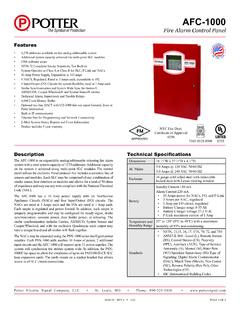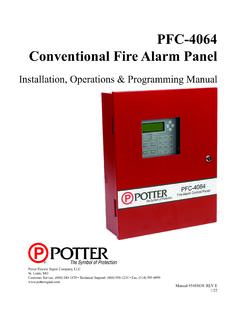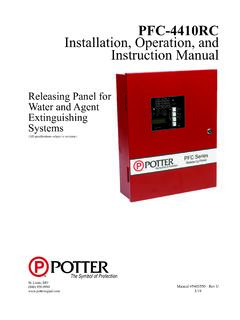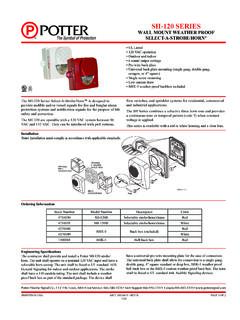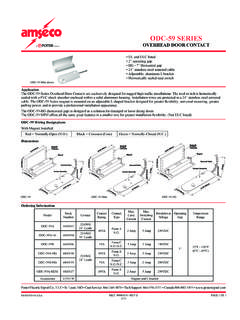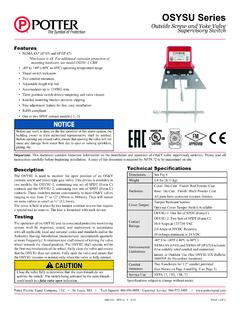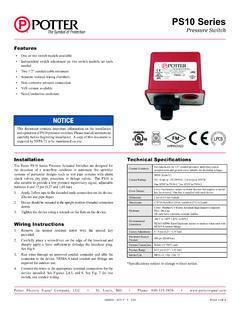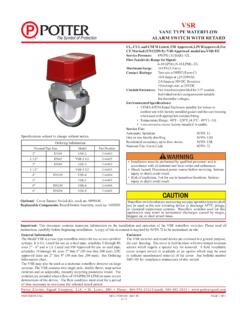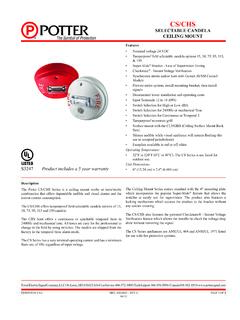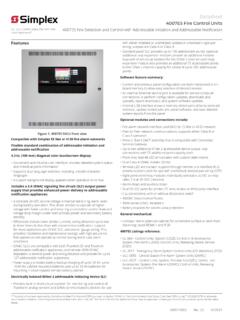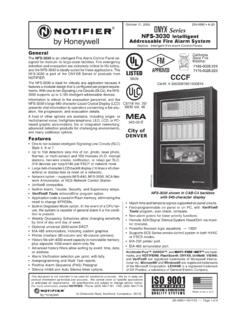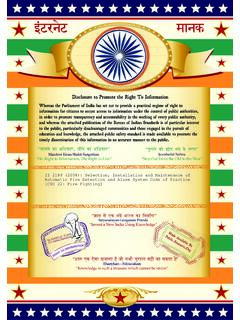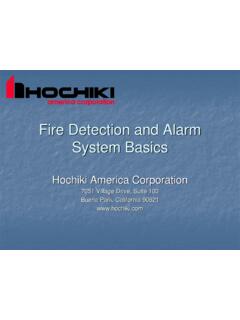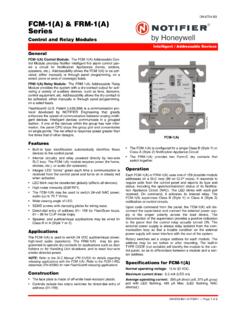Transcription of Advanced Fire Training Manual - Potter Electric: Fire ...
1 Advanced FireTraining ManualManual #8700055 Rev H5/17 Potter Electric Signal Company, LLCSt. Louis, MOCustomer Service: (866) 240-1870 Technical Support: (866) 956-1211 Fax: (314) IP ConnectivityP-Link CircuitSLC LoopNAC CircuitWA NLAN2 Advanced fire Training Manual 8700055 REV H 05/17 Potter Electric Signal Company, LLC 5757 Phantom Drive Ste 125 St. Louis, MO 63042 314-595-6900 800-325-3936 WARRANTY INFORMATIONThe essential purpose of any sale or contract for sale of any of the products listed in the Potter catalog or price list is the furnishing of that product. It is expressly understood that in furnishing said product, Potter does not agree to insure the Purchaser against any losses the Purchaser may incur, even if resulting from the malfunction of said warrants that the equipment herein shall conform to said descriptions as to all affirmation of fact and shall be free from defects of manufacture, labeling and packaging for a period of one (1) or five (5) year(s), depending on the product, from the invoice date to the original purchaser, provided that representative samples are returned to Potter for inspection.
2 The product warranty period is stated on the exterior of the product package. Upon a determination by Potter that a product is not as warranted, Potter shall, at its exclusive option, replace or repair said defective product or parts thereof at its own expense except that Purchaser shall pay all shipping, insurance and similar charges incurred in connection with the replacement of the defective product or parts thereof. This Warranty is void in the case of abuse, misuse, abnormal usage, faulty installation or repair by unauthorized persons, or if for any other reason Potter determines that said product is not operating properly as a result of causes other than defective manufacture, labeling or Aforesaid Warranty Is Expressly Made In Lieu Of Any Other Warranties, Expressed Or Implied, It Being Understood That All Such Other Warranties, Expressed Or Implied, Including The Warranties Of Merchantability And Fitness For Particular Purpose Are Hereby Expressly Excluded.
3 In No Event Shall Potter Be Liable To Purchaser For Any Direct, Collateral, Incidental Or Consequential Damages In Connection With Purchaser s Use Of Any Of The Products Listed Herein, Or For Any Other Cause Whatsoever Relating To The Said Products. Neither Potter Nor Its Representatives Shall Be Liable To The Purchaser Or Anyone Else For Any Liability, Claim, Loss, Damage Or Expense Of Any Kind, Or Direct Collateral, Incidental Or Consequential Damages Relative To Or Arising From Or Caused Directly Or Indirectly By Said Products Or The Use Thereof Or Any Deficiency, Defect Or Inadequacy Of The Said Products. It Is Expressly Agreed That Purchaser s Exclusive Remedy For Any Cause Of Action Relating To The Purchase And/or Use Of Any Of The Products Listed Herein From Potter Shall Be For Damages, And Potter 's Liability For Any And All Losses Or Damages Resulting From Any Cause Whatsoever, Including Negligence, Or Other Fault, Shall In No Event Exceed The Purchase Price Of The Product In Respect To Which The Claim Is Made, Or At The Election Of Potter , The Restoration Or Replacement Or Repair Of Such fire Training Manual 8700055 REV H 05/17 Table of ContentsSection 1: Introduction.
4 1-1 Manual Overview ..1-1 Section 2: fire Alarm System Requirements & System Overview ..2-2 fire Safety Code & Standard Requirements ..2-2 Occupancy Classifications ..2-3 fire System Equipment Components ..2-5 Sprinkler System Supervision Requirements ..2-6 Types of fire Systems ..2-6 Conventional Systems ..2-6 addressable Systems ..2-7 analog / addressable Systems ..2-8 Section 3: System Wiring ..3-9 Circuit Types Overview ..3-9 Class B Circuits ..3-9 Class A Circuits ..3-11 End of Line Resistor Supervision ..3-13 Initiating Device Circuits (IDCs) ..3-13 Notification Appliance Circuits (NACs) ..3-14 Signaling Line Circuit Overview ..3-15T-Tapping/Branch Circuits ..3-17 Isolator Devices ..3-18RS-485 Connections ..3-19 Section 4: Initiating Device Device Overview.
5 4-20 Installation Overview ..4-20 Manual Alarm Station Types ..4-20 Manual Alarm Station Installation Requirements ..4-21 Smoke Detectors ..4-22 Smoke Detector Installation Considerations ..4-23 Smoke Detectors in Residential Occupancies ..4-25 Residential Smoke Detector Types ..4-25 Residential Smoke Detector Location ..4-25 New Residential Installation Residential Installation Considerations ..4-26 Air Duct Smoke Detectors ..4-28 Duct Detector Requirements ..4-28 Heat Detectors ..4-29 Heat Detector Types ..4-29 Heat Detector Installation Considerations ..4-30 fire Sprinkler Panels ..4-31 Section 5: Notification Appliances Requirements ..5-32 Notification Appliances Overview ..5-32 Audible Notification Requirements ..5-33 Average Ambient Sound Level Guidelines.
6 5-33 Multiple Rated Audio Sounder Requirements ..5-34 Other Audible Device Installation Considerations ..5-354 Advanced fire Training Manual 8700055 REV H 05/17 Public & Private Modes Occupancy Requirements ..5-36 Visual Notification Requirements ..5-36 Installation Orientation ..5-37 Corridor Installation Requirements ..5-38 Candela Light Output Rating ..5-38 NFPA's Light Output Candela Requirements ..5-39 Multiple Candela Rated Visual Annunciators ..5-41 Types of Annunciators ..5-41 fire Alarm Signals ..5-42 Section 6: Communications Technology ..6-43 Digital Alarm Communicator Transmitter (DACT) ..6-43 DACT Overview ..6-43 Equipment Requirements for DACT Communications ..6-43 Transmission Requirements for DACTs ..6-44IP Communications ..6-45IP Communications Overview.
7 6-45IP Connection Types ..6-45 Equipment Requirements for IP Communications ..6-45 Transmission Requirements for IP Communications ..6-46 Communication Path Requirements ..6-46 Single Communication Path ..6-46 Multiple Communication Paths ..6-46 Radio Systems ..6-47 Radio Systems Overview ..6-47 Two-Way Radio Frequency (RF) Multiplex Systems ..6-47 Equipment Requirements for Two-Way Radio ..6-47 Transmission Requirements for Two-Way Radio Systems ..6-48 One-Way Radio Frequency (RF) Systems ..6-48 Equipment Requirements for One-Way Radio ..6-49 Transmission Requirements for One-Way Radio Systems ..6-49 Comparison of DACT, IP & Radio System Communications ..6-50 Section 7: Battery & SLC Calculation Worksheets / Submittal Documentation ..7-52 Calculation Overview.
8 7-52 Notification Voltage Drop ..7-52 Lump Sum Calculation Method ..7-53 Battery Standby Calculations ..7-53 Submittal Documentation ..7-55 Appendix A: Glossary & Definitions ..A-56 Appendix B: Control Panel Symbols ..B-62 Appendix C: Signal Initiating Devices & Switch Symbols ..C-64 Appendix D: Signal Indicating Appliances & Related Equipment Symbols ..D-67 Appendix E: System Installation & Troubleshooting Tips ..E-681-1 Advanced fire Training Manual 8700055 REV H 05/17 Section 1: IntroductionThe first standards for fire detection and alarm systems in the United States dates back to the 1800s. While these first fire alarms were simplistic, advances in technology have resulted in fire alarm systems that can be intimidating in their complexity. As fire alarm system technology continues to evolve, the basic functions of the fire alarm system remain unchanged.
9 A firm understanding of these basic functions are the building blocks used by a system designer to configure today's modern fire alarm OverviewThis Manual provides a comprehensive overview of fire detection and alarm system components. Topics include types of detection, notification, and control panels. The Manual also addresses submittal documentation that is required for the permit, installation and maintenance process. The table below summarizes the Manual 's content by 1: Overview of Manual ContentSectionDescriptionSection 2: fire Alarm System Requirements & System OverviewExplains how codes and standards impact the selection and installation of fire alarm systems. You'll learn how the building occupancy class determines the equipment required for each facility.
10 Types of fire alarm signals, and differences between conventional, addressable and analog / addressable fire alarm systems are also 3: System WiringExplains the differences between SLC Class A and Class B circuit wiring, use of isolators to provide greater system reliability, and other wiring options, , initiating device circuits (IDCs), isolators, and 4: Initiating Device RequirementsProvides details for properly installing smoke detectors based on location of air diffusers and fluorescent lighting fixtures, room dimensions, and other factors. Heat detector and Manual pull station location requirements in commercial buildings, and standards for new and existing residential sleeping areas are also 5: Notification Appliance RequirementsExplains the audible / visual notification appliance functions and requirements.
